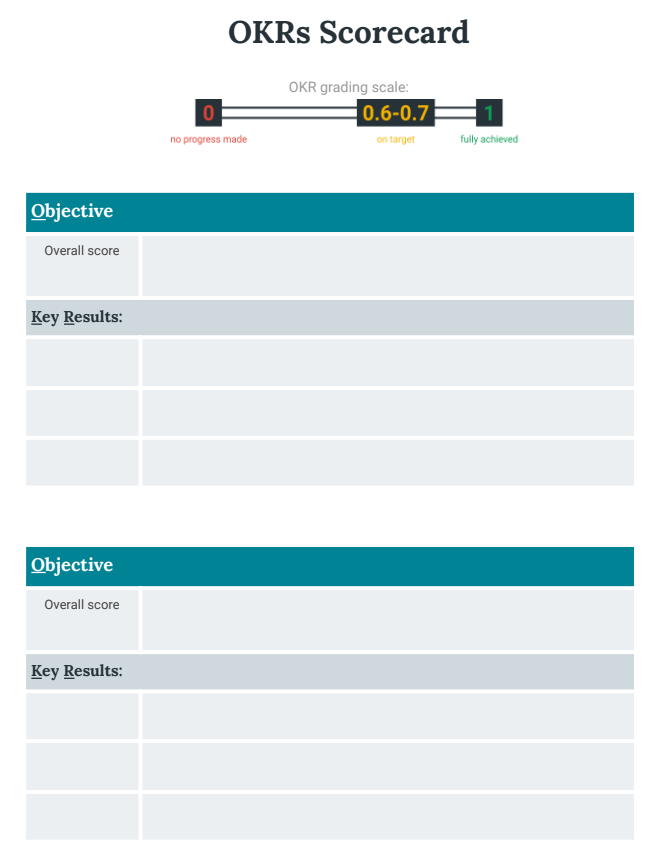Define Project Goals, Scope, and Success-criteria
Identifying Project Goals
Determing project goals and deliverables
Project goal: the desired outcome of the project
One of the biggest differences between what makes a good goal and a not-so-good goal is how well it’s defined.
- Well-defined goals: clear, specific, measurable
When you start a project, take time to review your goals and make sure they’re well-defined
Get more information from your stakeholders.
Talk to them about their vision for the project.
Ask how this aligns to the company’s larger goals and mission.
By the end of that conversation, you and your stakeholders should agree to support the project goals in order to avoid running into issues later on.
Project deliverables: products or services that are created for the customer, client, or project sponsor.
- I.e., deliverable is what gets produced or presented at the end of a task, event, or process. Example: a report.
- Deliverables help us quantify and realize the impact of the project.
- Deliverables are usually decided upfront with the stakeholders or clients involved in the project. They hold everyone accountable and are typically a big part of achieving the goal.
- Make sure to ask questions about what the deliverable should be and have everyone share their vision and expectations of the deliverables
Set SMART goals
SMART

SMART goals are very helpful for ensuring project success. SMART goals help you see the full scope of a goal, determine its feasibility, and clearly define project success in concrete terms.
Specific
The objective has no ambiguity for the project team to misinterpret.
- What do I want to accomplish?
- Why is this a goal?
- Does it have a specific reason, purpose, or benefit?
- Who is involved? Who is the recipient?
- Employees, customers, the community at large?
- Where should the goal be delivered?
- To what degree? (What are the requirements and constraints)
Measurble
Metrics help the project team determine when the objective is met.
Ask questions
How much?
How many?
How will I know when it’s accomplished?
You will need to measure most of the goals with metrics
- Not every metric will have value, so you will have to determine which metrics make sense for the project.
Consider benchmarks or points of reference to make sure you’re choosing accurate metrics
- Example: If your overall goal is to increase revenue, you can look at last year’s data as a benchmark for deciding how much to increase revenue this year. If last year’s revenue increased by three percent, then an increase by five percent in a booming economy would be a reasonable goal for this year.
Attainable
The project team agrees the objective is realistic.
Can it reasonably be reached based on the metrics?
Goals should be a little challenging to encourage growth, but shouldnot be too extreme or you will never reach it
Example: Say you regularly run 2.5 kilometers, three times a week. Your goal is to run a 5K.
Attainable: go from running 2.5 kilometers to running five kilometers within four weeks
Unattainable: earning first-place in the 5K
How can it be accomplished?
- Break down the goal into smaller parts and see if it makes sense
Relevant
The goal fits the organization’s strategic plan and supports the project charter.
- Does it make sense to try and reach this goal?
- Is the goal worthwhile?
- Does the effort involved balance out the benefits?
- Does it match your organizations’other need and priorities?
Everyone, from the client, the project team, and the people who will ultimately use the product, need to feel like the goal is worth supporting.
Factors that have big impacts
- The Amount of time the project will take
- The larger economic and social contexts
Ask questions
- Will the company be able to sustain the project over time?
- Is there an audience that will continue to use the product or service once it’s delivered?
If you still don’t feel confident about the project’s goals, keep digging. It’s okay to ask questions if you have doubts. Communicate your concerns with the project senior stakeholders and your direct supervisor if you have one. They should be able to address some of your concerns so that you can feel confident about moving forward.
Time-bound
The project team documents a date to achieve the goal.
Time-bound means your goal has a deadline.
- Deadlines give you a way to track your progress (otherwise you may never reach your goal or never even get started)
- Making your goal time-bound gives you a way to break down how much needs to be accomplished over time.
Examples
Example 1
You are looking to make a career change, and you set a goal to complete a Google Career Certificate. You can measure the success of this goal because after completing the entire program, you will receive a certificate—a tangible outcome.
Now, let’s determine how to make the remaining elements of this goal SMART. In this example, your specific goal is to attain a Google Career Certificate. You can make this goal attainable by deciding that you will complete one course per month. This goal is relevant because it supports your desire to make a career change. Finally, you can make this goal time-bound by deciding that you will complete the program within six months.
After defining each of these components, your SMART goal then becomes: Obtain a Google Career Certificate by taking one course per month within the next six months.
Example 2
“Office Green will soon create an app to help customers care for their plants.”
It is not specific, measurable, or time-bound. Here’s the same goal, rewritten as a SMART goal:
“Office Green will create an app that offers tips and reminders to help customers care for their plants. The app will be completed within 18 months and be compatible with 100% of the types of plants Office Green sells.”
After revisng to SMART goal, explain what makes them SMART by answering the following questions:
What makes the goal specific? Does it provide enough detail to avoid ambiguity?
The team knows what they’re building: an app that helps users care for their plants and reminds them to do so.
What makes the goal measurable? Does it include metrics to gauge success?
The app will be complete when it includes 100% of the plant types Office Green sells.
What makes the goal attainable? Is it realistic given available time and resources?
The company has the knowledge, time, resources to build the app.
What makes the goal relevant? Does it support project or business objectives?
Office Green’s business model relies on customers caring for their plants successfully.
What makes the goal time-bound? Does it include a timeline or deadline?
The goal includes an 18-month timeframe.
Example 3
Office Green, LLC, is a commercial landscaping company that specializes in plant decor for offices and other businesses. The company is getting ready to introduce its new Plant Pals service, which will provide high-volume customers with small, low-maintenance plants for their desks. You are the project manager assigned to manage the Plant Pals launch.
Office Green’s main goal for this project is: “Increase revenue by 5% by the end of the year by rolling out a new service that provides office plants to high-volume clients.”
You recently met with the project sponsor (the Director of Product) to discuss two additional goals for the Plant Pals project and below are the meeting notes:
- Boost Office Green’s brand awareness
- Office Green will promote the new service with a new marketing and sales strategy, a redesigned website with a new Plant Pals landing page, and a print catalog.
- Website traffic has dipped slightly over the past three years, from 15K to 13K visits each month. The Marketing Manager wants unique page visits to increase by at least 2K each month by the end of the year, which is in line with the results of prior marketing campaigns.
- The project is scheduled to launch by the end of the third quarter. The project team will continue to collect data on the project’s progress through the rest of the year and assess how well it has met its goals at the end of the fourth quarter. (It is currently the start of Q1.)
- Raise Office Green’s customer retention rate
- Office Green’s customer retention rate was 80% last year, but the CEO wants that number to increase by at least 10% this year.
- Last year, 70% of customers who left Office Green for competitors said they did so because they wanted more extensive services. When surveyed, 85% of existing customers expressed an interest in Plant Pals.
- The Vice President of Customer Success expects Office Green to achieve a customer satisfaction rating of over 90% this year—a slight increase over last year. The rating has stayed between 85%-90% for the last five years.
- The company plans to create an Operations and Training plan for Plant Pals to improve on existing customer service standards and boost efficiency.
- With the publicity around the launch, Office Green projects that their customer base will grow by at least 15%.
Rewrite these two goals as SMART goals:
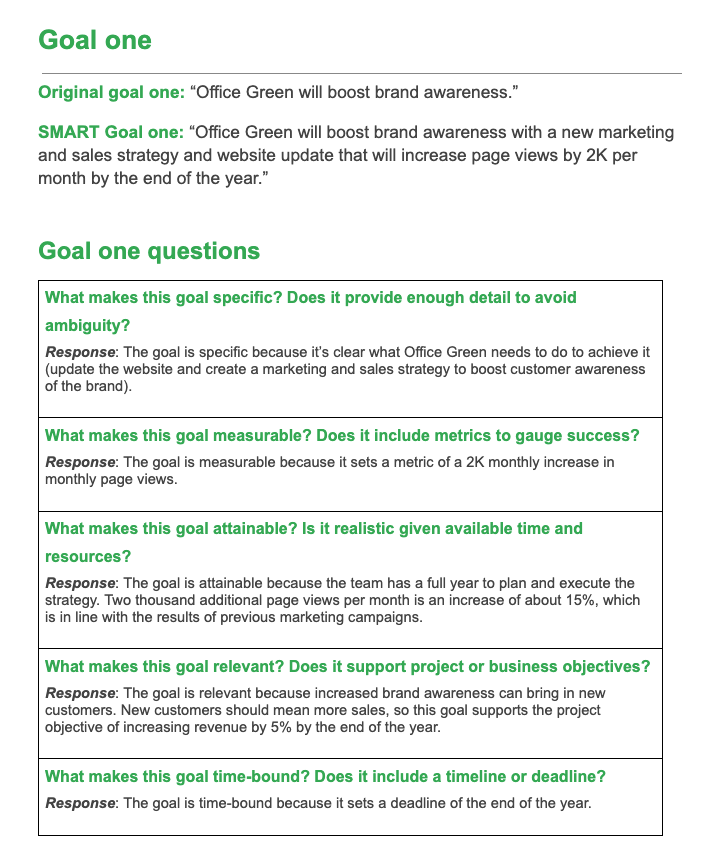
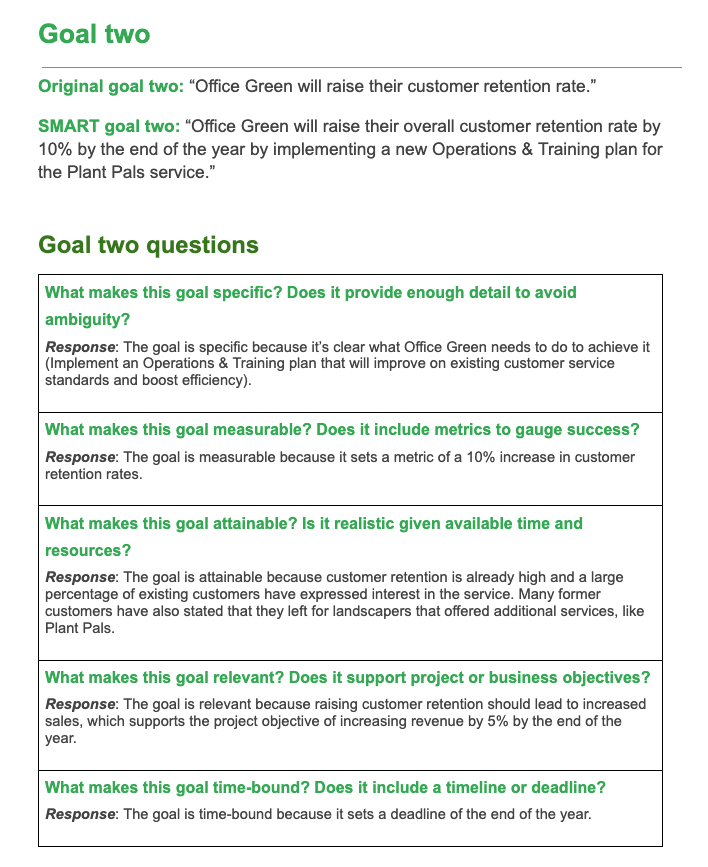
Objectives + Key Results (OKR)
OKR’s
Combine a goal and a metric to determine a measurable outcome.
Clearly state what the goal is
Provide specific details to measure the success of the goal
Separate the different components of SMART goals and clarify them even further, rather than grouping everything into one statement
Ojective (O)
- Defines what needs to be achieved (similar to goals)
- Describes a desired outcome, e.g.
- Increase in custom retention
- Improve the employee onboarding process
Key Results (KR)
The measurable outcomes that defines when the objective has been met.
Example
- Objective: Improve customer retention
- Key results: Achieve a 90% customer satisfcation rating by the end of Q1
OKR levels
- Company / Organization
- Commonly shared across an organization so that everyone is clear on the company’s goals.
- Usually updated on an annual basis to help drive the organization in the direction it wants to go.
- These high-level OKRs support the mission of the organization.
- Department / Team
- Support the company’s broader OKRs and help drive team performance
- Departments may develop OKRs that are more specific to their job function as well.
- Project
- Describe the focused results each group will need to achieve
- Should support and be aligned with company- and department-level OKRs
Advantages of OKR
- OKRs can help project manager expand upon project goals and further clarify the deliverables you will need from the project to accomplish those goals.
- Project-level OKRs help establish the appropriate scope for your team so that you can say “no” to requests that may get in the way of them meeting their objectives.
- Creating and using project-level OKRs can help motivate your team since OKRs are intended to challenge you to push past what’s easily achievable.
How to create OKRs for your project?
Set objectives
- Project objectives should be aspirational, aligned with organizational goals, action-oriented, concrete, and significant. Consider the vision you and your stakeholders have for your project and determine what you want the project team to accomplish in 3–6 months.
- Strong objectives meet the following criteria
- Aspirational
- Aligned with organizational goals
- Action-oriented
- Concrete
- Significant
- To help shape each objective, ask yourself and your team:
- Does the objective help in achieving the project’s overall goals?
- Does the objective align with company and departmental OKRs?
- Is the objective inspiring and motivational?
- Will achieving the objective make a significant impact?
- Examples
- Build the most secure data security software
- Continuously improve web analytics and conversions
- Provide a top-performing service
- Make a universally-available app
- Increase market reach
- Achieve top sales among competitors in the region
Develop key results
- Add 2–3 key results for each objective
- Key results should be time-bound. They can be used to indicate the amount of progress to achieve within a shorter period or to define whether you’ve met your objective at the end of the project.
- Key results should also challenge you and your team to stretch yourselves to achieve more.
- Criteria
- Results-oriented—not a task
- Measurable and verifiable
- Specific and time-bound
- Aggressive yet realistic
- To help shape your key results, ask yourself and your team the following:
- What does success mean?
- Does the key result help define success for your team?
- What metrics would prove that we’ve successfully achieved the objective?
- Is it specific and time-bound?
- Is it ambitious yet realistic?
- Examples:
- X% new signups within first quarter post launch
- Increase advertiser spend by X% within the first two quarters of the year
- New feature adoption is at least X% by the end of the year
- Maximum 2 critical bugs are reported monthly by customers per Sprint
- Maintain newsletter unsubscribe rate at X% this calendar year
Best practices
- Think of your objectives as being motivational and inspiring and your key results as being tactical and specific. The objective describes what you want to do and the key results describe how you’ll know you did it.
- As a general rule, try to develop around 2 – 3 key results for each objective.
- Be sure to document your OKRs and link to them in your project plan.
OKRs vs. SMART goals
While SMART goals and OKRs have some similarities, there are key differences, as well. This article describes how SMART goals and OKRs are similar, how they differ, and when you might want to use one or the other
To learn more how OKRs work to help project managers define and create measurable project goals and deliverables, check out the following resources:
- Google’s OKR playbook
- Planning company goals
- OKRs and SMART goals: What’s the difference?
- OKRs and KPIs: What They Are and How They Work Together
- How OKR and project management work together
- OKR Examples
- OKR TED Talk video (John Doerr, the founder of OKRs, explains why the secret to success is setting the right goals.)
Example
Wonder City is a mid-sized city where increasing growth and traffic are impacting quality of life. According to a recent market assessment, the region’s population is expected to double in the next five years. Job growth is also expected to increase by 48%. This growth will impact street networks, parking and mobility.
Wonder City has several city-wide objectives related to reducing traffic congestion and improving the city’s infrastructure. In order to support these city-wide objectives, the Wonder City Transportation Authority (WCTA) will be launching five new bus lines. This initiative has been nicknamed Project Move It.
You have been hired as the project manager for this initiative. As the project manager, you will set OKRs to help clarify the project goals and define what needs to be done in order to deliver a successful project.
Here is some additional information about the project:
- The project needs to be completed within two years.
- Community member buy-in and support for the locations of the new bus lines will be required.
- The project must adhere to all government regulations.
- Stops along the new bus lines must connect neighboring suburbs to downtown and public resource facilities.
- Bus lines must service at least 50% of the most densely-populated areas of Wonder City.
- The project is intended to help improve wait times and increase ridership.
- The plan includes a marketing campaign to promote the new lines.
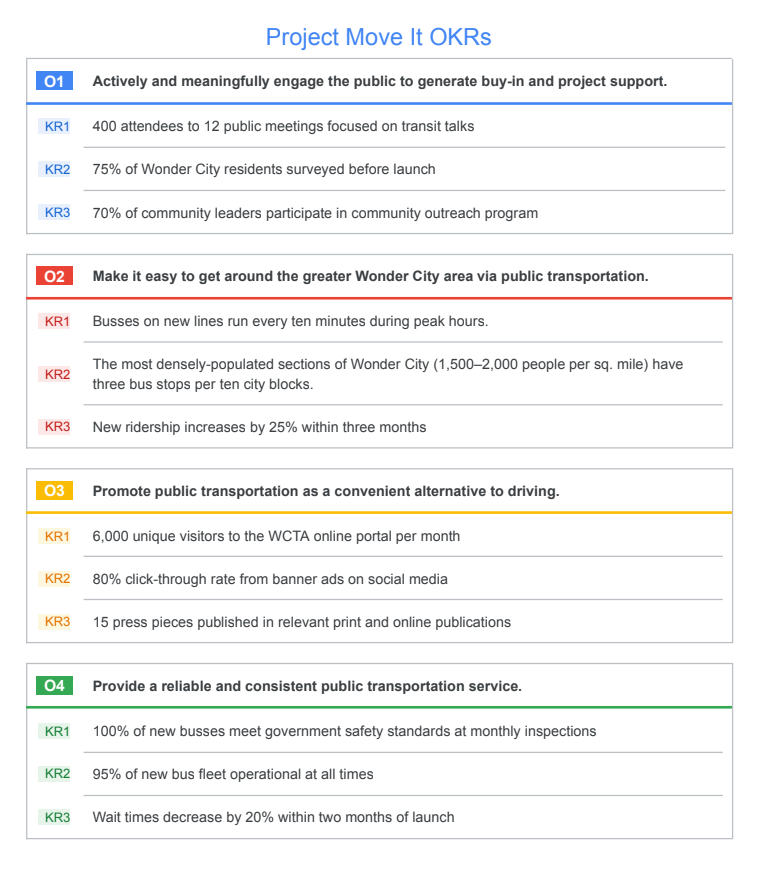
Defining Project Scope
What is a project scope?
Project scope includes the boundaries of a project, “an agreed upon understanding as to what is included or excluded from a project.”
- Scope helps ensure that your project is clearly defined and mapped out
- Who the project will be delivered to and who will be using the end result of the project
- Project’s complexity
- Scope includes the project timeline, budget, and resources.
- You define the scope to help identify necessary resources, resource costs, and a schedule for the project.
Helpful questions to ask when defining project scope
- Where did the project come from?
- Why is it needed?
- What is the project expected to achieve?
- What does the project sponsor have in mind?
- Who approves the final results?
Once you understand your project scope, you want to document all the details so that anyone can refer back to it throughout the life cycle of the project.
Gathering information to define scope
Example: Imagine that while working in a restaurant management group, your manager calls and asks you to “update the dining space,” then quickly hangs up the phone without providing further instruction.
Here are some questions you might ask your manager in order to get the information you need to define the scope of the project:
Stakeholders
- How did you arrive at the decision to update the dining space?
- Did the request originate from the restaurant owner, customers, or other stakeholders?
- Who will approve the scope for the project?
Goal
- What is the reason for updating the dining space?
- What isn’t working in the current dining space?
- What is the end goal of this project?
Deliverables
- Which dining space is being updated?
- What exactly needs to be updated?
- Does the dining space need a remodel?
Resources
- What materials, equipment, and people will be needed?
- Will we need to hire contractors?
- Will we need to attain a floor plan and building permits?
Budget
- What is the budget for this project? Is it fixed or flexible?
Schedule
- How much time do we have to complete the project?
- When does the project need to be completed?
Flexibility
- How much flexibility is there?
- What is the highest priority: hitting the deadline, sticking to the budget, or making sure the result meets all the quality targets?
Monitoring and maintaining a project’s scope
Task
In-scope: Tasks that are included in the project and contribute to the project’s overall goal
Out-of-scope: Tasks that are NOT included in the project and do NOT contribute to the project’s overall goal
It’s project manager’s job to set and maintain firm boundaries for your project so that your team can stay on track.
Scope creep
Scope creep: Changes, growth, and uncontrolled factors that affect a project scope at any point after the project begins
- A common problem, and it’s not always easy to control
- Can happen on any project, in any industry
- It can put stress on you, your team, and your organization. It can put your project at risk – can hinder every aspect of the project, from the schedule to the budget to the resources, and ultimately, its overall success.
Sources
External
- Customer requests
- Environment shifts
- Changes in technology
Solutions
- Make project plans visible
- Make sure the stakeholders have visibility into the project: details of what’s going to be produced, what resources are required, how much it will cost, and how much time it’ll take, etc.
- Get clarity on project requirements and ask for constructive criticism of the initial product proposal
- Set ground rules and expectations for stakeholder involvement
- Create a plan for dealing with out-of-scope requests
- Put your agreements and plans in writing
Internal
- Product improvements
- Processes chagnes
Strategies for controlling scope creep
Define your project’s requirements
Set a clear project schedule
Determine what is out of scope
Provide alternatives
Set up a change control process
Learn how to say no
Collect costs for out-of-scope work
Managing changes to a project’s scope
While your project will have its own specific goals, the overall goal for you as the project manager is to deliver the project according to the scope agreements, which includes delivering the project within the given deadline and the approved budget.
To decide if a scope change is acceptable and what impact it will have, project managers usually refer to the triple constraint model.
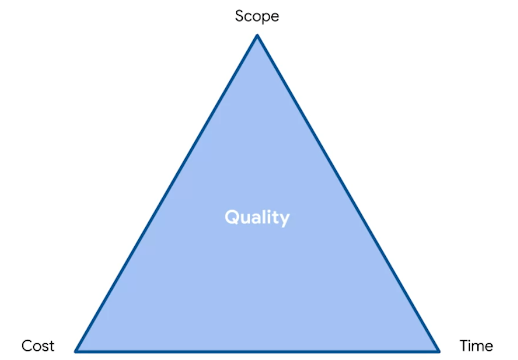
- Time: Project schedule and deadlines
- Cost
- Budget
- Resources and the people who will work on the project
Both time and budget have to be carefully managed alongside scope.
All three of these are linked. Changing one will have impact on the others.
-> It’s important to consider what trade-offs you’re willing to make as the project progresses.
You need a clear understanding of the project priorities.
You have to know what is most important when it comes to scope, time, and cost.
Measuring a Project’s Success
Lauching and landing a project
Launch: Delivering the final result of the project to the client or user.
Landing: Measuring the success of project using the success criteria established at the outset of the project.
- It’s important to define what a successful landing looks like for a particular project.
- A way to measure and help you ensure the success of your project is called success criteria
- Include all the specific details of your goals and deliverables, and it can be a guide so you know whether you’ve accomplished what you set out to do
- Set standards for how your project will be judged
Example: Lauching vs. Landing
Imagine you are a project manager for an eco-friendly organization. Your organization asks you to create a training program for middle school students in your county to teach them about the impacts of recycling. The county’s goal is to increase recycling by 20% over the next five years. You gather your team and start developing the learning content to build out this training program. It takes you and your team one year to complete the research, development, and production of this training.
When you hand over the training to the school district, you are launching the project.
In order to know your project actually lands at the intended goal, you need to check back in periodically over the next five years to see if the training program is on target to produce a 20% increase in recycling in the county.
Defining success criteria
Success criteria
- Tells you whether or not the project was successful
- Specific details of project goals, deliverables, requirements, and expectations
- The standards by which the project will be judged once it’s been delivered to stakeholders
Key points to determine success criteria
Go through your project goals and deliverables, review the scope, and identify the measurable aspects of the project
Get clarity from stakeholders on the project requirements and expectations
- Who ultimately says whether or not the project is successful?
- What criteria will be measured to determine success?
- What’s the success of this project based on?
Once you’ve collected clarifying information, document and share all of it so that you, your team, and your stakeholders can refer to it later.
Once you’ve defined the metrics that you’ll be measuring as success criteria, think about how you track these metrics
Evaluate which tools can help you collect the data you need to ensure you’re staying on track
Along with each success criteria on your list, include also
the methods for how success will be measured
how often it’s measured
who’s responsible for measuring it
Share your success criteria document with your stakeholders and ask if they agree with how the project’s success will be determined.
It’s also a good idea to have the appropriate stakeholders sign off on the success criteria.
Keep this documentation visible throughout the duration of the project and clearly communicate it with your team every step of the way.
If done correctly, defining success criteria should create greater alignment within the team and give everybody better visibility into how to achieve success.
Tracking and communicating success criteria
Prodcut quality
The product attributes that are necessary for the product’s success include completeness in features, quality of features, unit cost, usability, etc
To keep us on track for success, we can create a list of product requirements to ensure that you do not miss anything. To measure the success of a product, consider including these metrics on your checklist:
- Track if you implemented the product’s priority requirements
- Track and assess the product’s number of technical issues or defects
- Measure the percentage of features you delivered or released at the end of the project
Consider customers and stakeholders
You can measure the fulfillment of strategic goals via user or customer metrics. Metrics to consider include:
- Evaluating user engagement with the product
- Measuring stakeholder and customer satisfaction via surveys
- Tracking user adoption of the product by using sales data
Document, align, and communicate success
You need to get clarity from stakeholders on the project requirements and expectations
- Who ultimately says whether or not the project is successful?
- What criteria will be measured to determine success?
- What is the success of this project based on?
- …
It is best practice to get the key stakeholders or the steering committee to review and approve your success criteria. This becomes a mutual agreement on how all parties define the success of the project.
Success criteria template
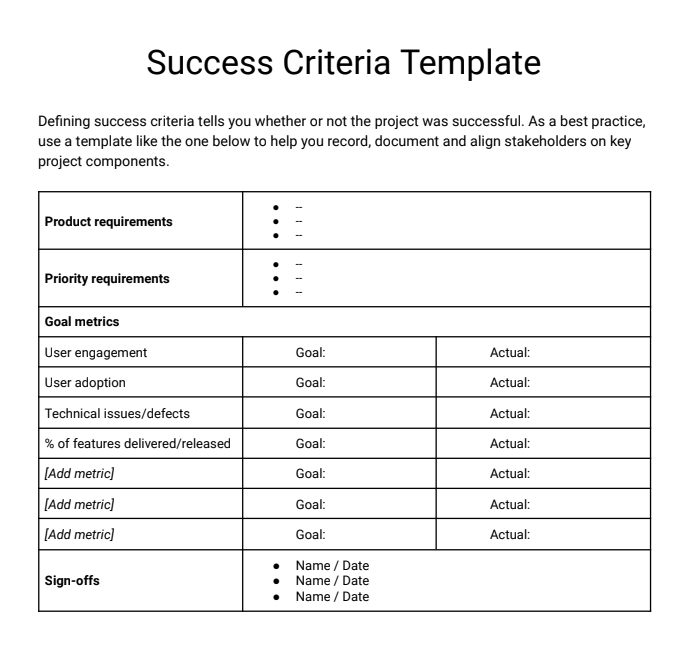
Use OKRs to evaluate progress
Communicating and tracking OKRs
Conducting regular check-ins and actively tracking progress with your team can help ensure that objectives are being met and that any issues are resolved as soon as possible.
- Share your OKRs with your team by sharing a digital document, presenting them in a meeting, or adding them to an internal website.
- Assign owners. Assign an owner to every key result so that everybody knows who’s responsible for what. This helps add clarity and increases accountability.
Measuring process
- One shortcut to determining the status of a project is to score or grade your OKRs.
Determine how you will score your OKRs
- The simplest approach to scoring OKRs is the “yes/no” method, with “yes” meaning you achieved your objective and “no” meaning you didn’t.
- A more advanced scoring approach is to grade your key results on a scale.
Set your scoring expectations
- For OKRs graded according to percentage achieved, the sweet spot is somewhere in the 60–70% range.
- Scoring lower may mean the team is not achieving what it could be. Scoring higher may mean the aspirational goals are not being set high enough.
Schedule checkpoints
- It’s important to regularly communicate the status of project OKRs with your team and senior managers.
- Typically, at the end of the quarter, you’ll grade each of your OKRs to evaluate how well the team did to achieve its goals.
OKR scorecard template
